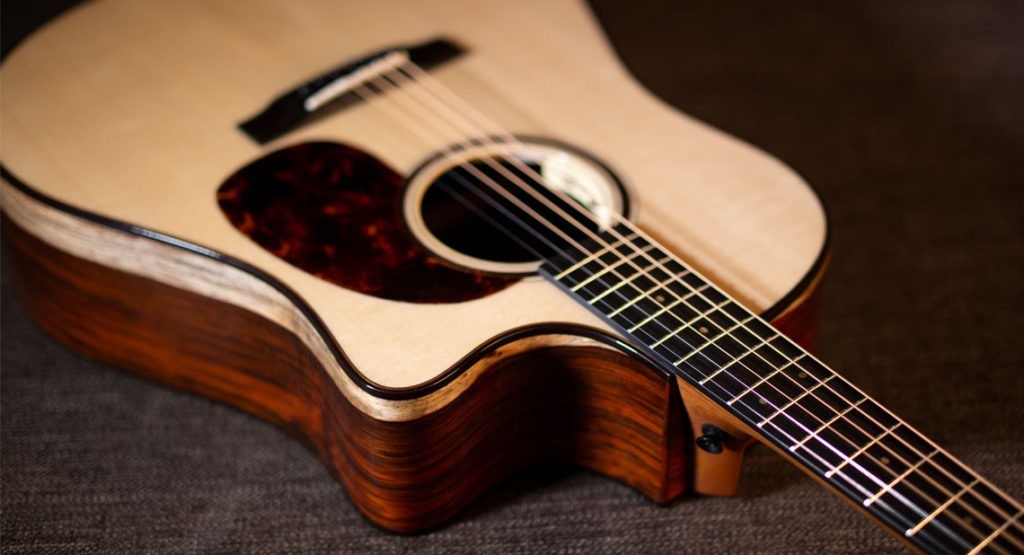The allure of Adirondack spruce, the sound of the Golden Age

No other guitar top tonewood has the history, the ambition, or the sheer power, sustain and dynamic range of Adirondack spruce.
Brazilian rosewood, with its haunting, swirling purple hues and its sweet thunderstorm of overtones, may well be the most vaunted guitar tonewood of all. Its rarity alone, not to mention its endangered status and the post-CITES global illegality of its harvesting and trade since 1992, has made it a subject of hushed, reverent tones even among those who can’t tell a headstock from a hand grenade.
But rosewoods of all varieties simply play a supporting role in guitars. They are not the star.
That title goes to top woods, and in that realm, the most vaunted, the most hailed, the most desired, the most aspired to, is … Picea Rubens.
Red spruce.
Or, to call it what you’re waiting for, Adirondack.
In the much hallowed Golden Age of American guitar building, the combination of Brazilian rosewood and Adirondack spruce virtually defined what has come to be known simply as a “pre-war guitar.” Honduran mahogany played a role, too, but in both cases the instruments’ amazing voices were the result of Picea Rubens.
Despite the laser-like location of its name, Adirondack spruce actually grows in a northeast-heavy corridor from Nova Scotia to North Carolina, embracing, along the way, the mountain range (itself part of the Appalachians) that shares its name. The trees, majestic conifers with gently fragrant yellow-green needles, can grow as tall as 150 feet, with trunks two feet across and occasionally larger. Some have stood for nearly 450 years.
When carefully milled, red spruce produces stiff, straight boards whose sole true desire is to become guitar tops—not Christmas trees, paper pulp or packing crates. And what tops they are!
Enthusiasts fall over themselves searching for terms to top the tannins, burnt sugars and floral notes of the oenophile—robust, springy, clear, complex.
What it really comes down to is energy.
Adirondack spruce tops, due in part to legendary rigidness across and along the grain, translate the player’s intent—the slash of a pick, the caress of a finger, the genteel strum of a thumb—into sonic energy.
Adirondack produces a strong fundamental, with vibrant sustain, which allows the species of the back and sides, cocobolo perhaps, or koa, to do its work. With rosewood, for example, it unleashes what is often referred to as a ‘bloom’ of nuance, a singing wash of sound, with round bass and bell-like treble, accompanied by an organic reverb-like hum. Over mahogany, notes hang like a chord on a church organ.
Red spruce also has a wider dynamic range than any of its cousins, with plenty of distortion-free headroom. Engelmann, softer, silkier, is just right for fingerpickers. European has been long favored by classical guitar luthiers for its slightly darker tone. And Sitka, the most democratic of tops, is the people’s sound, ready to play.
Adirondack is bolder, but takes breaking in. Adirondack is an investment, a commitment that will continue to bear new surprises over the years, the decades and beyond. Just ask Tony Rice, David Grier or Neil Young.
Picea Rubens is currently featured in a number of Bedell models, including the new Spotlight Series of limited edition high performance cutaway dreadnoughts, as well as in the Revolution, Coffee House and 1964 Special Edition lines.
And, of course, as per the Bedell Tonewood Certification Project, the Adirondack spruce used by Bedell’s handcrafters and artisans has been legally and ethically procured, with a clear, documented chain of custody. No clear-cut wood is ever used in Bedell guitars.
Namesake Tom Bedell is rightfully proud of the new dreadnoughts, which join Adirondack with Brazilian and East Indian rosewoods as well as the aforementioned cocobolo and koa. Bedell Guitars has one of the world’s largest, legal, fully documented collections of Brazilian rosewood, which it also pairs with Adirondack in the Bahia series.
The latter, Sound Optimized and hand voiced like all Bedell guitars, are tuned to the fundamental frequencies of instruments of the 1930s and echo those great pre-war guitars, with exquisite, yet understated appointments and all the tone and power you would expect from such a vintage combination.
“I call the 1964 Special Edition dreadnought the ‘Bluegrass Monster,’” says Bedell.
“Mahogany is just so rich, and has such a great midrange. It fits right in with a group of other instruments, but still stands out. In essence, the 1964 Special Edition dread is an upgraded version of a D-18 and the Coffee House is an upgraded version of a D-28, with an Adi top and East Indian rosewood back and sides.”
In Bend, Oregon, Bedell is making yesterday’s guitars today, with the same attention to detail and the same quality of materials that defined the Golden Era. If you want that classic, ringing, powerful sound of Adirondack spruce, it’s within easy reach. Touch tradition now.

